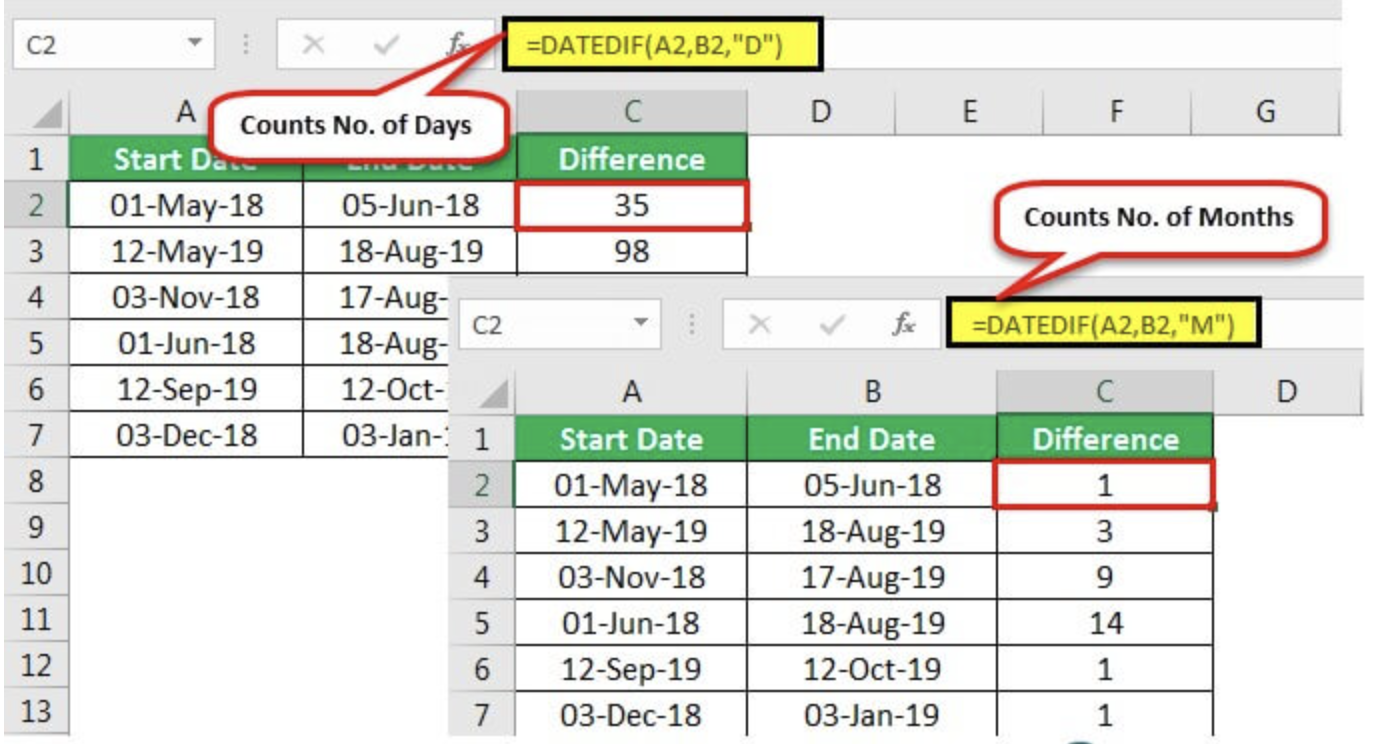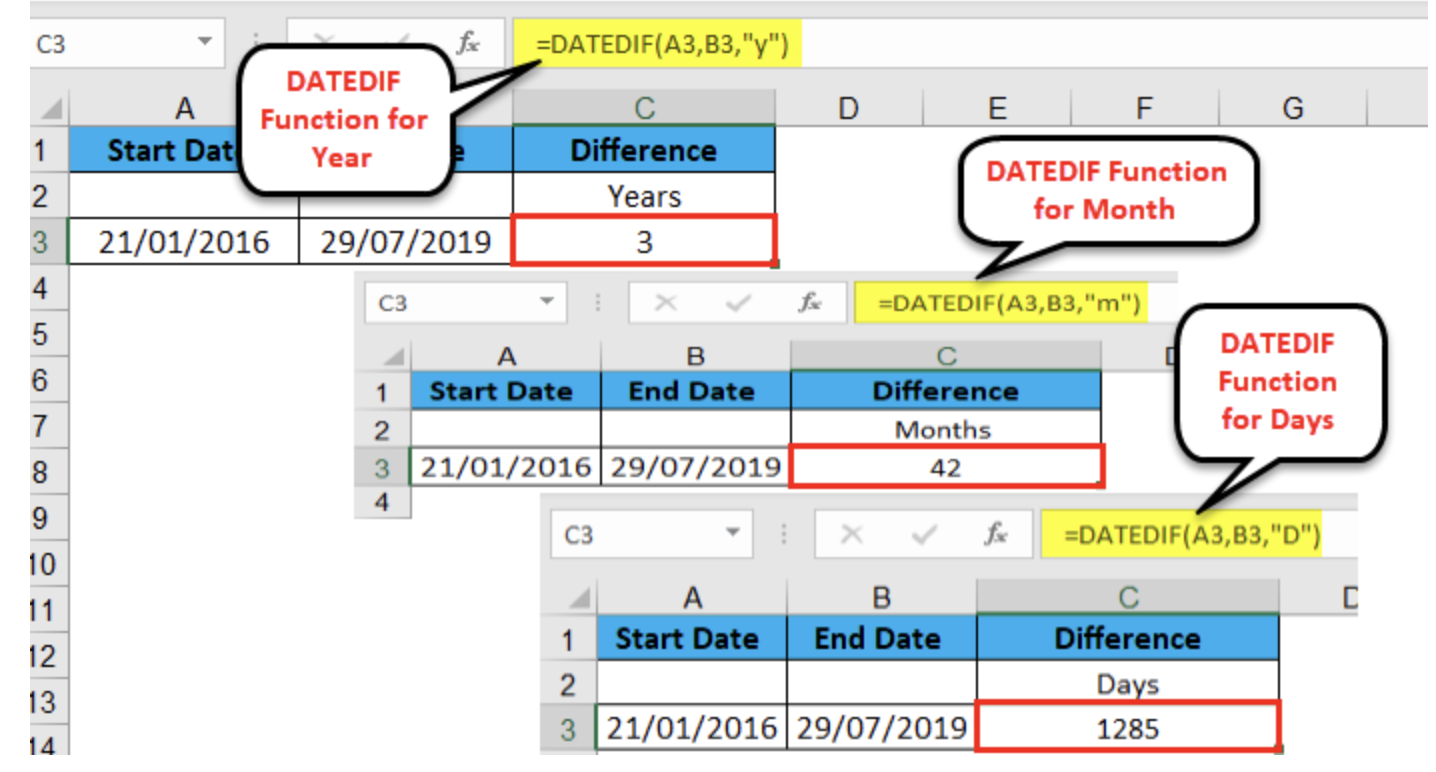Working professionals
Fresh graduates
- Study abroad
- Offline centres
More
27. Columns in Excel
33. Count In Excel
49. Slicers in Excel
54. Solver in Excel
56. Macros In Excel
How to Use DATEDIF Formula in Excel
Let’s discuss the DATEDIF Excel formula today. This function is handy for calculating the difference between two dates in several units, such as days, months, or years. But, first thing’s first; if you’re a beginner and still don't know your way around this spreadsheet software, take up an Excel certification course.
Having worked with Excel functions time and time again, I’ve had my fair share of experience with DATEDIF. I’ve made this guide to help beginners like you master a simple Excel function like this.
Happy learning!
What Is Datedif in Excel?
The DATEDIF Excel function is used to find the difference between two given dates. The differences could be in years, months, or days. It takes two dates as an argument and one keyword to specify which type of difference is desired for the output.
The output for this function is an integer, and the method to use this function is:
=DATEDIF(start_date, end_date, unit)
However, DATEDIF function Excel is compatible with Excel 2000 and previous versions of Excel.

Source: wallstreetmojo.com
For example, take 1/1/2013 as a start date in column A5 and 31/7/17 as an end date in column B5. Now with that, let’s find out the difference between the two days in column C. In this case we can use the DATEDIF function Excel.
The formula we can use is:
=DATEDIF(A5, B5,”C”)
Therefore, it will give us 1,672 days.
Formula
The DATEDIF function (Exce)l has the following arguments:
- Start_date – As the name suggests, it is a required argument. it is the initial date of the period.
- End_date – It represents the last, or ending, date of the period. It is also considered as a required argument.
- Unit – The time unit in which we want the information.
“Y” | The function “Y” returns the number of complete years in the period, giving the difference in complete years. |
“M” | The function returns the number of complete months in the period. Gives results for complete months. |
“D” | The function returns the number of complete Days in the period and gives the results for differences in complete Days. |
“MD” | The months and years of the dates are ignored here. This helps calculate the variation between the start_date and end_date. |
“YM” | It evaluates the difference between the months in start_date and end_date. The days and years of the dates are ignored here. |
How To Use DATEDIF Excel Function?

Source: educba.com
The DATEDIF function Excel is super useful for calculating the difference between two dates in different units like years, months and days. Here’s a step-by-step guide:
- Step 1: Understand the Syntax:
The syntax for the DATEDIF function.is =DATEDIF(start_date, end_date, unit)
- start_date: Enter the first date.
- end_date: Then the later date up to which you want to calculate the difference.
- unit: Incorporate the specific unit in which you want the variations to be calculated, like "d" for days, "m" for months, or "y" for years.
- Step 2: Use the Function:
Let's say you have two dates and want to find out the number of days separating them. How can you do it?
Use the function:
=DATEDIF("start_date", "end_date", "d")
Write "start_date" in place of "end_date" with the actual cell values consisting of your dates.
- Step 3: Calculating Months or Years:
To find out the difference in months or years, simply replace the unit with "m" or "y" respectively.
For example:
=DATEDIF("start_date", "end_date", "m")
=DATEDIF("start_date", "end_date", "y")
- Step 4: Handling Leap Years and Partial Months:
Be aware that the DATEDIF function Excel cannot handle leap years or partial months perfectly. It treats all years as having 365 days and may round up or down inconsistently when dealing with partial months.
- Step 5: Practical Example:
Suppose you have a project starting on January 2, 2024, and ending on April 29, 2024. For this, count the number of days the project will last. Type the function below:
=DATEDIF("02/01/2024", "04/29/2024", "d")
This formula is used for calculating the number of days between two dates. You can experiment on your own spreadsheets and see how it can simplify your date-related tasks.
Advantages of Using DATEDIF Excel Function
Excel is one easy-to-use tool that helps in simplifying data analysis and manipulation tasks. I’ve charted some advantages of using this function here:
- The DATEDIF function (Excel) simplifies dynamic data analysis by allowing users to perform calculations based on changing dates. This is mostly useful for tracking durations or projecting future milestones.
- DATED IF Excel smoothly integrates with other Excel functions, improving its utility. Users can combine DATEDIF with functions like TODAY() or DATE() to create dynamic date ranges or perform complex date calculations within larger formulas.
- You will need this function only when it requires more control.
Disadvantages of DATEDIF Excel Function
While DATEDIF function Excel is a handy tool for calculating date differences, it also comes with disadvantages. Keep the following limitations in mind to avoid mistakes:
- The DATEDIF funtion (Excel) allows only six types of intervals or can help find the variation between only six types of units.
- It cannot control so many types of units like the first day of the week.
- Since DATEDIF Excel does not handle future dates properly, especially when calculating differences in months or years, It may return unexpected results or errors when the end date is in the future, making it unsuitable for certain forecasting or planning scenarios.
- DATEDIF is not officially in Excel's built-in support system, which may confuse users seeking information about its usage or behavior. Its non-standard nature also means that updates or changes to Excel's functions may affect its reliability in future versions.
- The DATEDIF Excel function only gives you the formula if you use the correct date format in Excel.
Some Important Things To Keep In Mind
The DATEDIF Excel function has great utility but is often used incorrectly by many Excel users. Here are some important aspects of the DATEDIF function in Excel to remember:
- Inclusive dates: The DATED IF formula excludes the start date but includes the end date in its calculation. This means if you want to include both the start and end dates in your calculation, you have to adjust your result accordingly.
- Consistency in date format: Both start and end dates should be in a format recognizable by Excel. Excel remembers the dates entered in standard formats like "dd/mm/yyyy" or "mm/dd/yyyy". Date formats having inconsistency may result in errors or unexpected outcomes.
- Handling different units: The unit argument in the DATEDIF function Excel determines the type of result you'll receive. Here are some common units:
- "d" or "D": Calculates the difference in days.
- "m" or "M": Calculates the difference in months.
- "y" or "Y": Calculates the difference in years.
- Avoiding negative results: When calculating differences between dates, especially when using units like months or years, be cautious of negative results. Excel may return negative values if the end date is before the start date. To avoid this, you may need to adjust your data or use conditional formulas to handle such cases appropriately.
- Hidden function: Although the DATEDIF is a hidden function but can be used like any other Excel function. You can type it directly into a cell or the formula bar.
Wrapping Up
To sum things up, learning the DATEDIF Excel function enables you to calculate dates effectively. It ultimately aids greatly in most date-related data analysis tasks. Speaking of data analysis, mastering Excel is a key skill if you want to pursue it as a career. upGrad’s offers several courses that can kickstart your professional journey in this field. These online courses can equip you with the skills you need to climb the corporate ladder and reach the pinnacle of success.
Frequently Asked Questions
1. How do I use Datedif in Excel?
Enter “=DATEDIF(start_date, end_date, unit). It helps in calculating years between A1 and B1. Enter “ =DATEDIF(start_date, end_date, unit) . It helps in calculating years between A1 and B1. How do I calculate dates in Excel?
2. How do I calculate dates in Excel?
Enter “=TODAY() to show the current date, i.e, =DATE(year, month, day) to create a specific date, or =DATEDIF(start_date, end_date, "unit") to find the difference between two dates in various units (e.g., years, months, days). Enter “ =TODAY() to show the current date, i.e, =DATE(year, month, day) to create a specific date, or =DATEDIF(start_date, end_date, "unit") to find the difference between two dates in various units (e.g., years, months, days). How do I calculate days in Excel?
3. How do I calculate days in Excel?
From the end date subtract the start date, using an easy formula called =end_date - start_date this is how you can calculate days in Excel. From the end date subtract the start date, using an easy formula called =end_date - start_date this is how you can calculate days in Excel. What is the formula for Datedif today?
4. What is the formula for Datedif today?
Write formula `=DATEDIF(start_date, end_date, "unit")`, where "start_date" and "end_date" represent the dates you wish to find the difference between, and "unit" denotes the unit of time ("y" for years, "m" for months, "d" for days, etc.). Write formula ` =DATEDIF(start_date, end_date, "unit") `, where "start_date" and "end_date" represent the dates you wish to find the difference between, and "unit" denotes the unit of time ("y" for years, "m" for months, "d" for days, etc.). How do you add a Datedif formula?
5. How do you add a Datedif formula?
Type "=DATEDIF(start_date, end_date, "unit")" into a cell, replacing "start_date" and "end_date" with the appropriate dates and specifying the desired unit of time ("y" for years, "m" for months, "d" for days, etc.). Type " =DATEDIF(start_date, end_date, "unit") " into a cell, replacing "start_date" and "end_date" with the appropriate dates and specifying the desired unit of time ("y" for years, "m" for months, "d" for days, etc.). How to calculate age using Datedif?
6. How to calculate age using Datedif?
You need to subtract the birthdate from the current date, specifying "y" as the unit to calculate the difference in years. How do I use Datedif in numbers?
7. How do I use Datedif in numbers?
Type "=DATEDIF("start_date", "end_date", "unit")" in place of "start_date" and "end_date" into a cell. With the relatable dates and specifying the desired unit of time ("y" for years, "m" for months, "d" for days, etc.). Type " =DATEDIF("start_date", "end_date", "unit") " in place of "start_date" and "end_date" into a cell. With the relatable dates and specifying the desired unit of time ("y" for years, "m" for months, "d" for days, etc.).

Author|15 articles published


upGrad Learner Support
Talk to our experts. We are available 7 days a week, 10 AM to 7 PM
Indian Nationals
Foreign Nationals
Disclaimer
The above statistics depend on various factors and individual results may vary. Past performance is no guarantee of future results.
The student assumes full responsibility for all expenses associated with visas, travel, & related costs. upGrad does not .























-ae8d039bbd2a41318308f8d26b52ac8f.svg)
-35c169da468a4cc481c6a8505a74826d.webp&w=128&q=75)
-7f4b4f34e09d42bfa73b58f4a230cffa.webp&w=128&q=75)



